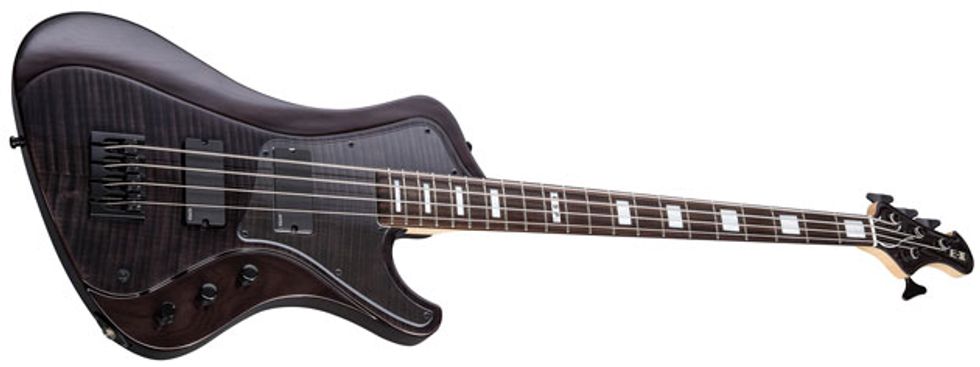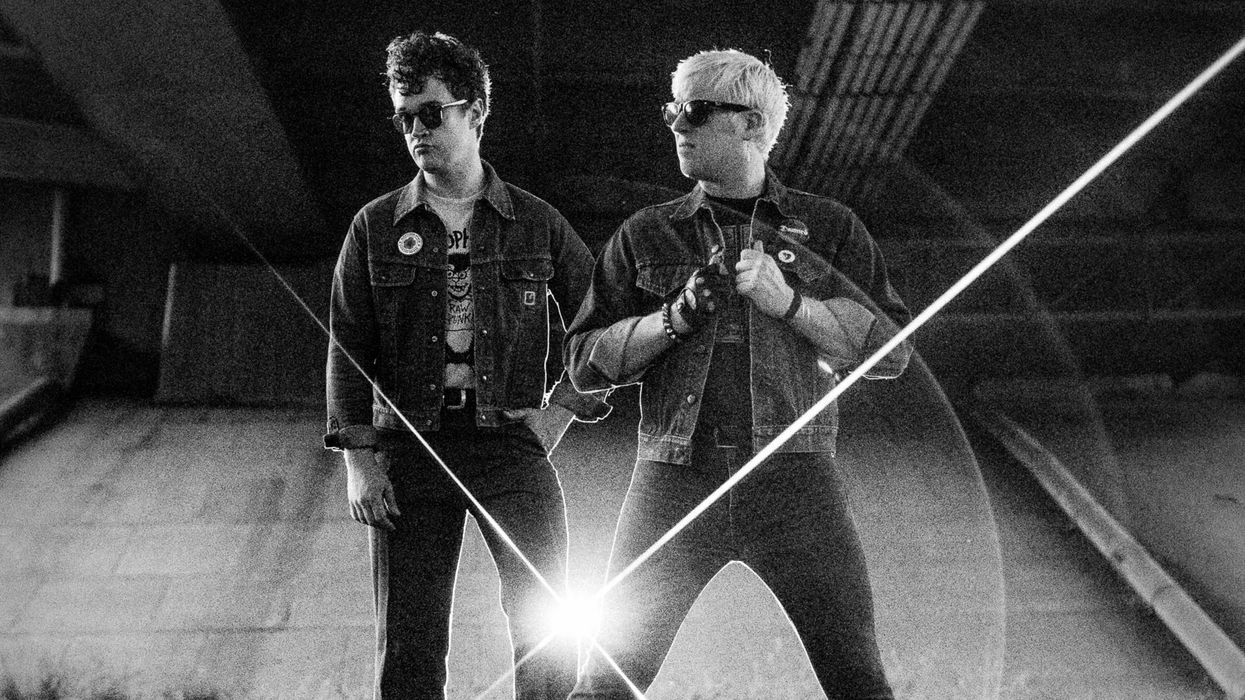ESP’s Stream bass series combines a fresh take on reverse-style bass design and contemporary tones. One might wonder after gazing at the sleek, eye-catching curvatures what the classic Gibson Thunderbird would have looked like if reimagined by H.R. Giger. The Stream models are certainly among the most distinctive-looking basses in ESP’s catalog, and their wide-ranging price points offer several options to fit within varying budgets.
The E-II Stream is built in ESP’s Japanese facility, and its price sits in the middle ground between the handcrafted ESP Original Stream model and the more affordable LTD Stream-204. It serves up deliciously thick P/J-style tones with definition and power, and possesses a level of playability that places it alongside some of the finer basses the company has produced.
Contoured Character
The 34"-scale E-II Stream’s string-through, white-ash body certainly pulls a lot of influence from the T-bird, but ups the ante with more pronounced curvature, a contoured upper bout, a deeper cutaway, and a shapely carved top located in its center. The E-II Stream includes an ESP hardshell case and our review model sported a transparent black finish with a flame maple top (available for a $100 upcharge).
Its bolt-on maple neck is carved with ESP’s “thin U” contour, which gives it a silky smooth feel that’s a pleasure to play. The profile manages to offer enough mass for comfortable fretting without inhibiting fast runs along the fretboard. The large block inlays on our model’s 21-fret rosewood fretboard were perfectly cut and inlaid, and the setup right out of the box was spot-on.
The E-II Stream’s tones are delivered via a combo of EMG 35P4 and 35J active pickups. They might look like humbuckers, but they’re actually single-coils designed to perform together like a traditional P/J setup. The neck position’s 35P4 contains an offset pair of P-style coils, and the 35J in the bridge houses a version of EMG’s standard J-style single-coil. The bass is also equipped with a 2-band stacked EQ, switchable boost, pickup blend, master volume, Gotoh tuners, and a Hipshot style-A bridge.
Stream of Consciousness
The unplugged resonance of the E-II Stream was impressive. I could feel the neck and body vibrate against my body as I fingerpicked notes in both the upper and lower registers, indicating a strong bond between the ash body and maple neck. Thanks to the body’s large mass, the bass felt very balanced across my shoulders when I strapped it on—a trait that a lot of basses with reverse-style designs can’t lay claim to.
Eager to hear how the E-II Stream performed amplified, I connected it to a Verellen Meatsmoke running into an Ampeg 8x10 cabinet and set the amp to a neutral clean tone. The bridge pickup sounded full and meaty, with plenty of bite and definition in the lower midrange. The clarity of fingerpicked notes on the lower frets was something to behold, and I was able to coax a little bit of edginess on the highs with ease when I struck the strings with a slightly more forceful attack. The tone’s clarity gave it more of a modern hi-fi quality, as opposed to the warmer and velvety sound that Jazz-style basses are known for.
Ratings
Pros:
Clear, authoritative, and highly responsive tones. Superbly comfortable neck.
Cons:
It’s spendy. Traditionalists might not gel with its flashy looks.
Tones:
Playability:
Build/Design:
Value:
Street:
$1,999
ESP E-II Stream Bass
espguitars.com
The bridge pickup’s thick lows and aggressive mids make it an ideal choice for metal and hard rock. After I flipped the onboard boost switch, the tone suddenly gained a lot more volume and took on even more upper midrange edge. The boost didn’t muddy up the sound one bit, which was helpful when I dug into the strings with a pick for driving Exodus-style thrash rhythms. That said, I did have to pull back the Meatsmoke’s midrange to around 10 o’clock to keep the tone from becoming too nasal. The real fun began when I switched gears and started slapping and popping, and the added midrange snarl from the boost circuit helped the notes project with a nice, funk-friendly thump.
The EMG 35P4 in the neck delivered exquisitely bubbly and bottom-heavy tones with light fingerpicking, and snarled with a raucous midrange when using a pick. The tones I got from the neck pickup were expectedly fuller and more open sounding than those I coaxed from the bridge, but the difference in volume and sheer heft went well beyond what I expected.
The familiar P-bass punch was there in spades, but it was mixed with a dose of T-bird low-end thickness that enveloped me as I stood in front of the amp. In an attempt to tame the lows, I found myself fiddling with the onboard bass EQ control quite a bit, and consequently I discovered a huge range of useable tones for jazz, R&B, and even doom metal.
When blending the two pickups for rock and pop phrases, I kept the blend knob at around 30 percent neck and 70 percent bridge. If I wanted to thicken up and loosen the lows, I simply dialed in a bit more of the neck pickup and dropped the treble knob slightly to allow the mids to be heard a little better.
The VerdictThe E-II Stream is a great sounding bass that will work for a number of players across a variety of styles. Likewise, it’s a great choice for those who are looking for a bass with a unique flair that doesn’t stray too far from the ordinary. Still, hard-core traditionalists who live and die by vintage tone and looks might shy away from its flashiness and clear-cut modern tones, and its relatively high price could scare some off. Hopefully it doesn’t come to that, because the E-II Stream’s impeccable build and wide range of responsive tones makes it worthy of a serious look.








![Rig Rundown: AFI [2025]](https://www.premierguitar.com/media-library/youtube.jpg?id=62064741&width=1245&height=700&quality=70&coordinates=0%2C0%2C0%2C0)












 Shop Scott's Rig
Shop Scott's Rig















































